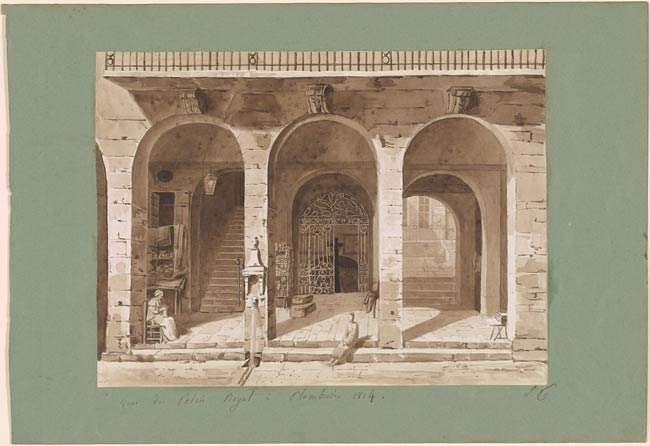
By the early nineteenth century, making drawings was becoming more common among talented aristocratic amateurs, many of whom were women, such as Cochelet. From a politically active Champagne family, Cochelet occupied a position of historical interest: she was a reader and lady-in-waiting to Queen Hortense, who had married Napoleon's brother Louis, king of Holland, in 1802. Divorced and living in Paris with her son, the future Napoleon III, Hortense fled the city in 1814, accompanied by Cochelet. Hortense remained in exile, except during the brief reign of Louis Philippe, until she died in 1837.
Cochelet learned to draw alongside her patron. Hortense's peintre du cabinet, Jean-Baptiste Isabey (1767-1855), had recommended his pupil Auguste Garneray (1785-1824) as drawing instructor for the women, whose drawing sessions Isabey joined on occasion. Making studies must have become a habit for Cochelet, who, in her memoirs, recorded, “every morning, I spent time drawing.” As was her practice, Cochelet inscribed the subject, date, and her initials on the mount. The sheet is from a dismantled album of her drawings, suggesting she kept the works as remembrances of her travels.
In 1814, with Napoleon's exile to Elba and the Bourbon Restoration, the queen and her retinue left Paris under the protection of Russian tsar Alexander I, only to return briefly the following year during Napoleon's 100-day rule before being banished from France by Louis XVIII. The group headed east and en route to Germany stopped in Plombières-les-bains, a town in Lorraine, south of Nancy, near the Meuse River. Plombières was a well-known site for thermal bathing cures, and had been visited in the 1580s by the great Renaissance essayist Michel de Montaigne. A section of Cochelet's memoirs recounts their journey and aspects of their stay there, which was characterized by peace and solitude.
Inscribed, dated and initialed on mount below drawing in pen and brown ink, "Vue du Palais Royal à Plombières 1814 LC", numbered on verso in graphite, "2".
Thaw, Eugene Victor, former owner.
Thaw, Clare, former owner.
Thaw Catalogue Raisonné, 2017, no. 54, repr.
The Thaw collection of master drawings : acquisitions since 2002. New York : Morgan Library & Museum, 2009, no. 17, repr.
